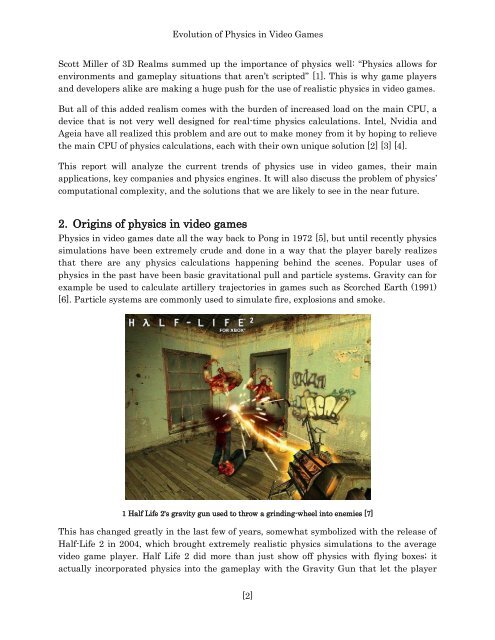Evolution of Physics in Video Games - lafur Andri
Evolution of Physics in Video Games - lafur Andri
Evolution of Physics in Video Games - lafur Andri
You also want an ePaper? Increase the reach of your titles
YUMPU automatically turns print PDFs into web optimized ePapers that Google loves.
<strong>Evolution</strong> <strong>of</strong> <strong>Physics</strong> <strong>in</strong> <strong>Video</strong> <strong>Games</strong><br />
Scott Miller <strong>of</strong> 3D Realms summed up the importance <strong>of</strong> physics well: “<strong>Physics</strong> allows for<br />
environments and gameplay situations that aren‟t scripted” [1]. This is why game players<br />
and developers alike are mak<strong>in</strong>g a huge push for the use <strong>of</strong> realistic physics <strong>in</strong> video games.<br />
But all <strong>of</strong> this added realism comes with the burden <strong>of</strong> <strong>in</strong>creased load on the ma<strong>in</strong> CPU, a<br />
device that is not very well designed for real-time physics calculations. Intel, Nvidia and<br />
Ageia have all realized this problem and are out to make money from it by hop<strong>in</strong>g to relieve<br />
the ma<strong>in</strong> CPU <strong>of</strong> physics calculations, each with their own unique solution [2] [3] [4].<br />
This report will analyze the current trends <strong>of</strong> physics use <strong>in</strong> video games, their ma<strong>in</strong><br />
applications, key companies and physics eng<strong>in</strong>es. It will also discuss the problem <strong>of</strong> physics‟<br />
computational complexity, and the solutions that we are likely to see <strong>in</strong> the near future.<br />
2. Orig<strong>in</strong>s <strong>of</strong> physics <strong>in</strong> video games<br />
<strong>Physics</strong> <strong>in</strong> video games date all the way back to Pong <strong>in</strong> 1972 [5], but until recently physics<br />
simulations have been extremely crude and done <strong>in</strong> a way that the player barely realizes<br />
that there are any physics calculations happen<strong>in</strong>g beh<strong>in</strong>d the scenes. Popular uses <strong>of</strong><br />
physics <strong>in</strong> the past have been basic gravitational pull and particle systems. Gravity can for<br />
example be used to calculate artillery trajectories <strong>in</strong> games such as Scorched Earth (1991)<br />
[6]. Particle systems are commonly used to simulate fire, explosions and smoke.<br />
1 Half Life 2's gravity gun used to throw a gr<strong>in</strong>d<strong>in</strong>g-wheel <strong>in</strong>to enemies [7]<br />
This has changed greatly <strong>in</strong> the last few <strong>of</strong> years, somewhat symbolized with the release <strong>of</strong><br />
Half-Life 2 <strong>in</strong> 2004, which brought extremely realistic physics simulations to the average<br />
video game player. Half Life 2 did more than just show <strong>of</strong>f physics with fly<strong>in</strong>g boxes; it<br />
actually <strong>in</strong>corporated physics <strong>in</strong>to the gameplay with the Gravity Gun that let the player<br />
[2]


